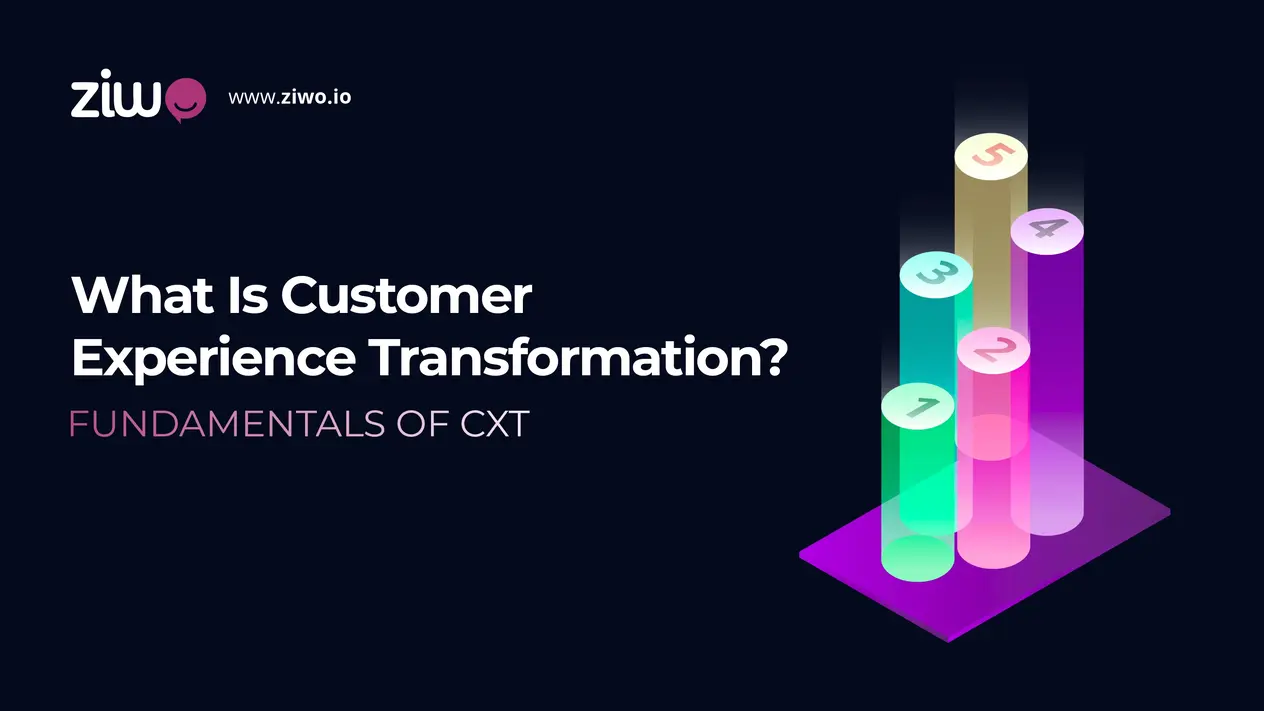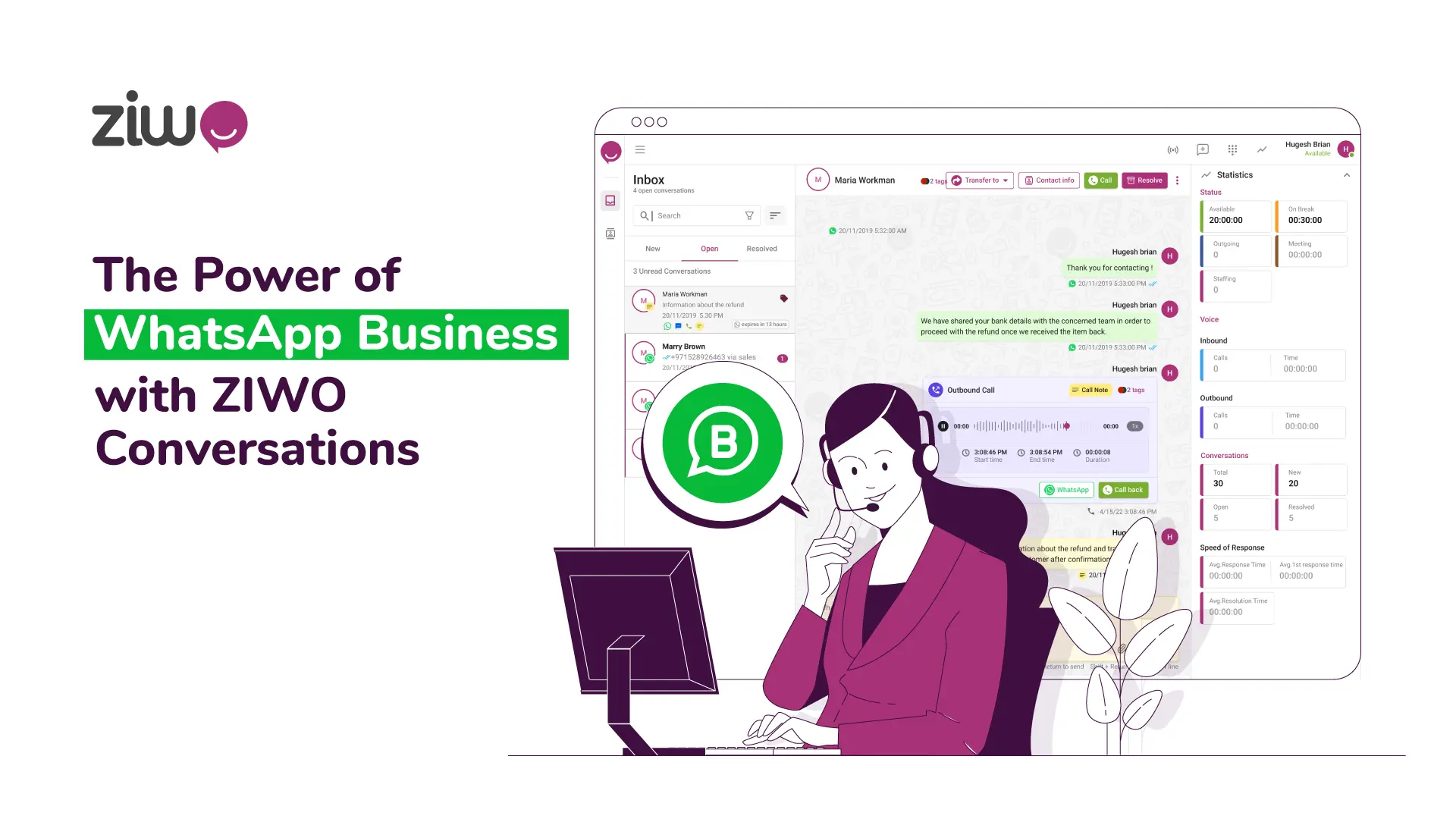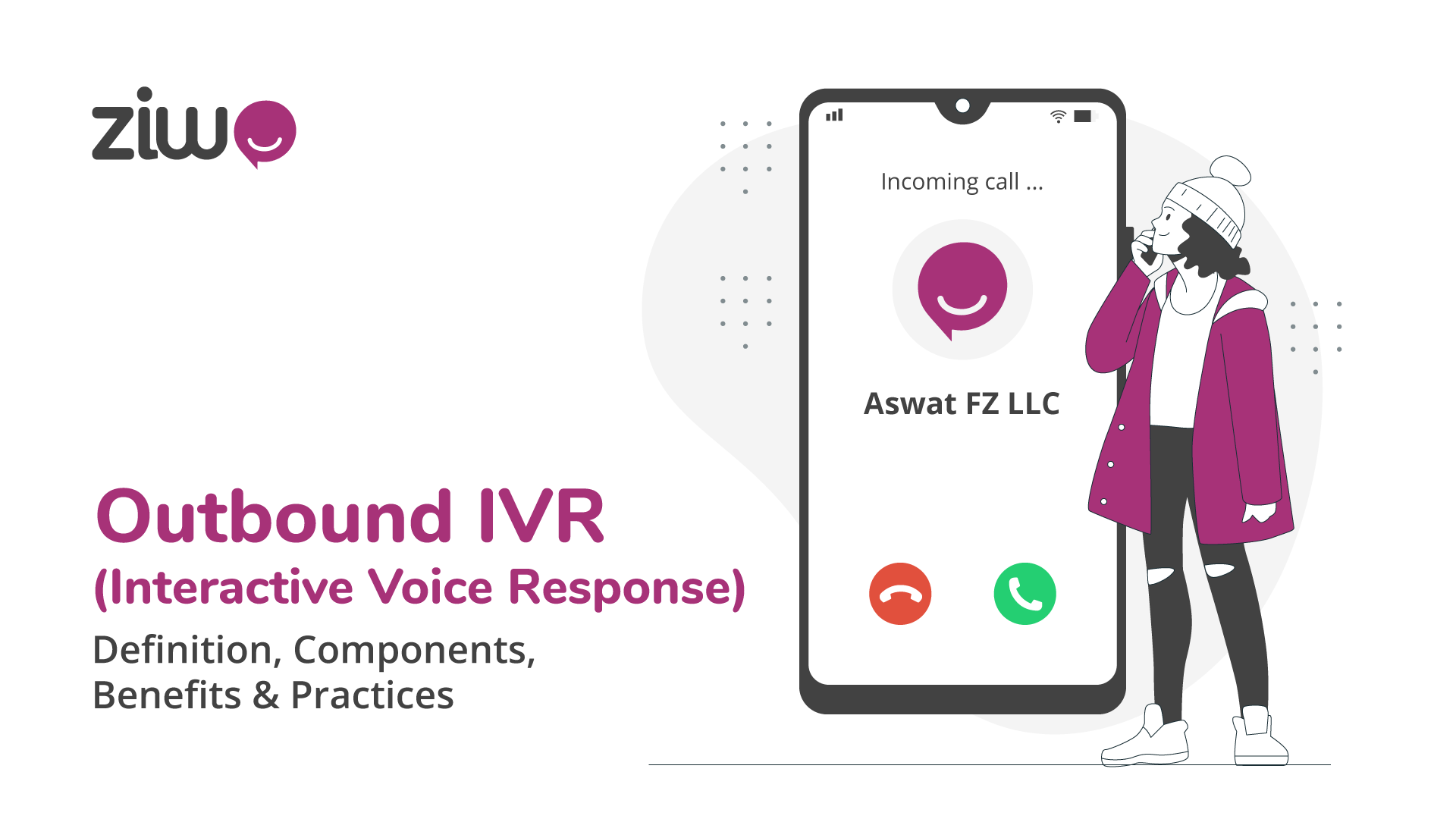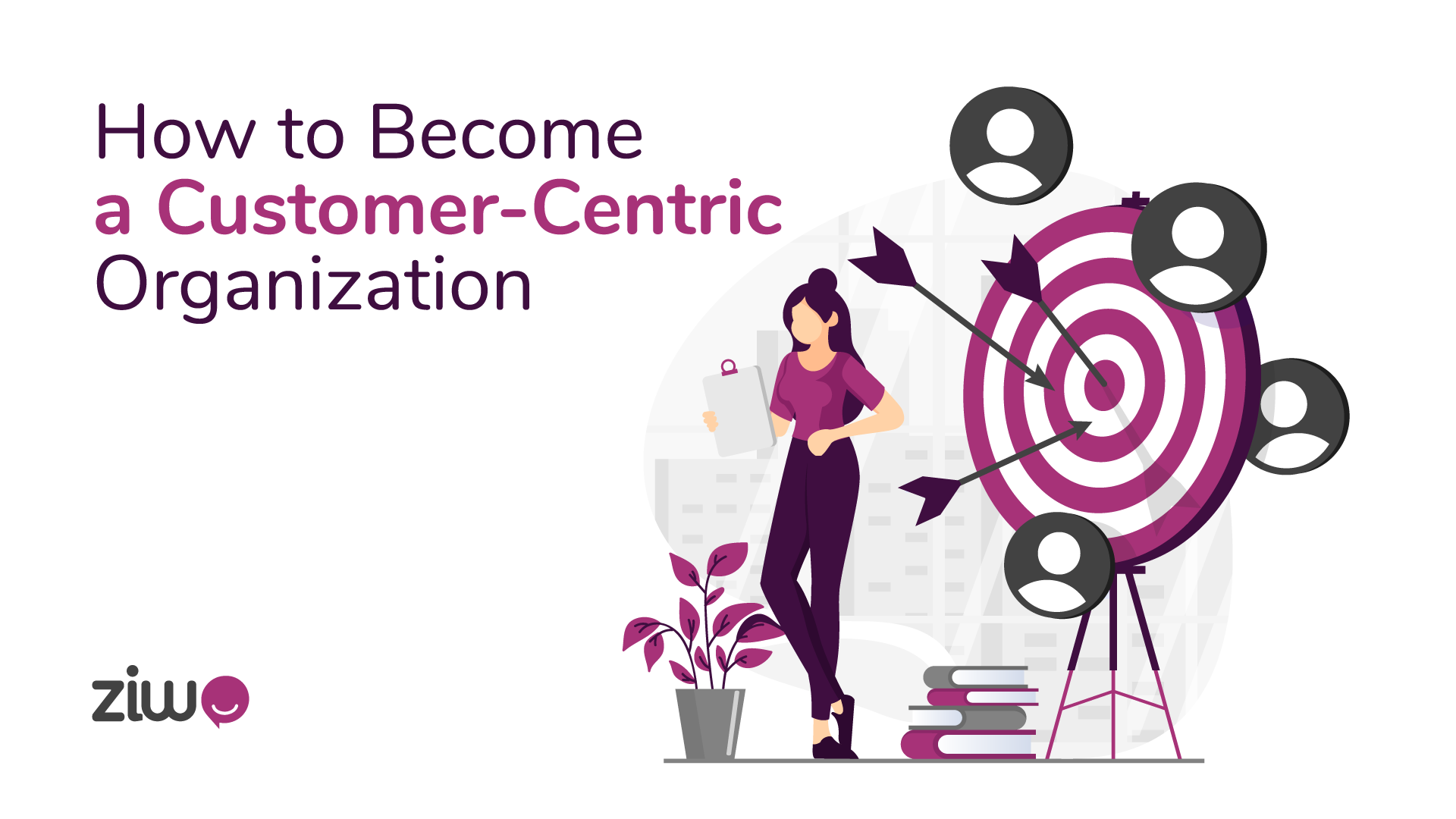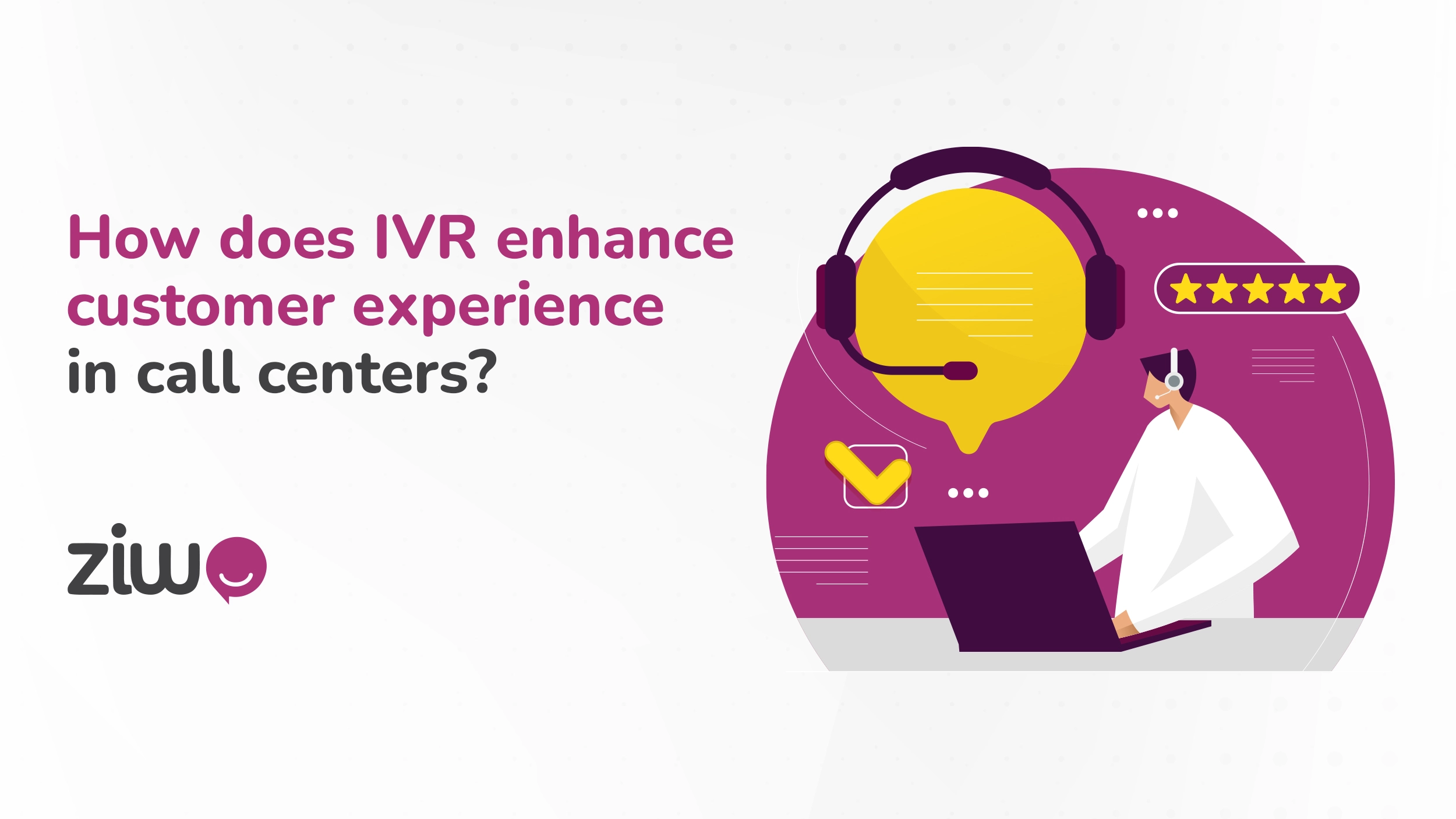
Comment l'IVR améliore-t-il l'expérience des clients dans les centres d'appels ?
"Une communication claire garantit une augmentation des dépenses des clients de 2,4 fois la norme.
"72 % des clients passent à la concurrence après une mauvaise expérience avec une marque spécifique.
Vous savez que perdre un client revient à sacrifier un actif. Après avoir pris connaissance des résultats de l'étude précédente, vous vous demandez : "Comment mon entreprise pourrait-elle maintenir une communication claire pour permettre à mes clients de dépenser davantage et les empêcher de prendre la décision de partir ?"
La réponse est simple : L'ajout d'une fonctionnalité commerciale comme l'IVR améliore l'expérience client dans un centre d'appels dans le cloud et dans d'autres centres.
Tout au long de cet article, vous acquerrez toutes les connaissances nécessaires pour améliorer l'expérience client via l'IVR. Ainsi, votre entreprise pourra tirer pleinement parti des avantages offerts par cette technologie dans les centres d'appels, qu'il s'agisse d'une efficacité accrue ou d'une meilleure satisfaction de la clientèle.
Introduction : Le rôle de l'IVR dans le service à la clientèle
La technologie de réponse vocale interactive (IVR) permet aux clients d'accéder à des informations par le biais de messages vocaux préenregistrés, en interagissant avec eux en fonction de leurs préférences. Elle est cruciale dans les centres d'appels cloud modernes pour améliorer l'expérience client.
Les principes de base de la technologie IVR
L'interaction vocale avec les clients est réalisée par le biais de la technologie de reconnaissance vocale ou des entrées tactiles, en utilisant la technologie IVR pour une expérience client transparente dans les centres d'appels. La conception du système comprend le matériel, les logiciels, les fonctionnalités clés et le développement de scripts.
Comment fonctionne l'IVR : Un aperçu technique
D'aucuns pourraient penser que l'aperçu technique d'un IVR est difficile à comprendre. Pourtant, c'est assez simple. Comme toute autre technologie, il se compose d'un logiciel et d'un matériel.
1- Matériel du SVI
Le matériel se compose principalement d'équipements de téléphonie, y compris les serveurs, les téléphones IP ou tout autre appareil informatique, les lignes numériques et les pilotes VOIP.
- Lignes téléphoniques numériques: Alors que les lignes analogiques transforment la voix en signaux électriques, les lignes numériques sont distinctives. Le temps est venu de convertir la voix en signaux binaires que les réseaux comprennent. Cela garantit la clarté et la cohérence.
- Pilotes VOIP: Cette technologie permet d'envoyer la voix sur l'internet au lieu de la transmettre par les lignes téléphoniques traditionnelles. Cela se fait par le biais d'une connexion internet à large bande, permettant un transfert de données élevé par fibre optique, sans fil, câble, DSL et satellite.
- Téléphones IPou appareils informatiques : L'agent peut utiliser ces appareils pour prendre des appels entrants et passer des appels sortants. Il peut s'agir de téléphones à protocole Internet, mais ils sont surtout devenus des PC, des ordinateurs portables et des smartphones.
- Serveurs: Ils sont utilisés pour héberger les bases de données, les logiciels de centre d'appels, les sauvegardes de données et les solutions de reprise après sinistre.
2- Logiciel IVR
Le logiciel maintient une connexion internet stable pour que l'appel soit clair pour les deux parties. Le logiciel IVR gère également les appels entrants et offre des fonctionnalités de mise en file d'attente et d'acheminement des appels, de reconnaissance vocale et d'intégration des données avec d'autres solutions logicielles de soutien. Les logiciels comprennent
- IP PBX: l'une des principales unités de contrôle de la téléphonie IP est l'autocommutateur privé, qui permet la commutation, le routage et la mise en file d'attente des appels sur l'internet.
- Téléphone logiciel: Une applicationconçue en interne qui peut être utilisée sur vos appareils, qu'il s'agisse de téléphones ou de PC. Les softphones sont des composeurs numériques qui permettent aux agents de prendre des appels entrants et de lancer des appels sortants.
- Passerelles VOIP: Connecteurs qui permettent aux agents de recevoir et d'émettre des appels au sein du réseau téléphonique public commuté (RTPC). Ainsi, le numéro affiché sera un numéro de téléphone local traditionnel. Les appels peuvent donc aller et venir entre la téléphonie IP et le RTPC.
- Contrôleurs de session (SBC) : Les considérations de sécurité sont cruciales pour garantir une accessibilité sûre aux utilisateurs et aux clients. Les SBC garantissent que seuls les agents autorisés peuvent passer et recevoir des appels et accéder au réseau. Les SBC protègent le réseau établi contre les attaques non autorisées.
La mise en place d'un centre d'appels sur site nécessite des éléments spécifiques, tandis que l'adoption d'une solution de softphone pour centre de contact dans le cloud permet de réaliser des économies en ne nécessitant que l'appareil de l'agent et l'infrastructure informatique de base.
Principales fonctionnalités des systèmes IVR
Explorons les fonctionnalités importantes des systèmes IVR et ce qui les rend uniques. Ces fonctionnalités sont au service des agents et des clients.
1- Routage des appels
Le système IVR permet aux clients d'être dirigés vers différents départements en fonction de leurs besoins. Par exemple, Adam peut joindre le service des ventes pour une demande de renseignements sur un produit en appuyant sur la touche 1 du clavier, tandis que John peut joindre le service d'assistance technique pour un problème de produit en appuyant sur la touche 2.
2- Informations préenregistrées
Le système IVR permet à l'organisation à but non lucratif 123 de gérer des fonds pour des campagnes de lutte contre la pauvreté et de continuité de l'éducation. Les clients peuvent facilement identifier leur numéro de compte bancaire grâce à un message automatisé, ce qui réduit la charge de travail des agents humains. Ce système couvre les questions courantes et les questions fréquemment posées, telles que les heures d'ouverture, l'emplacement et les instructions de base.
3- Gestion des files d'attente
Adam et John ont de nouveau appelé votre centre d'appel. Chacun d'entre eux a une file d'attente différente et s'adresse à d'autres agents. Cependant, le centre d'appel avait un trafic important ce jour-là, et le système IVR leur permettait d'attendre 2 minutes ou de demander à être rappelés. Numéro d'identification personnel (DID) a choisi d'attendre et a appuyé sur 1, tandis que John n'a pas eu le temps d'attendre et a appuyé sur 2.
Les longs délais d'attente ont toujours été un cauchemar pour les clients. Désormais, l'IVR rend l'attente plus efficace, offrant ainsi une meilleure expérience.
4- Vérification humaine
Les fonctionnalités qui traitent des informations sensibles sur les clients, comme les banques, les hôpitaux, etc., ajoutent généralement cette fonction à leur système IVR. L'IVR demande au destinataire de l'appel son numéro d'identification national, sa date de naissance ou tout autre caractère spécial qui approuve l'identité de l'interlocuteur. Cela permet de protéger la vie privée et la sécurité du client avant que le système ne transfère l'appel à l'agent.
5- Collecte des commentaires
Une autre fonctionnalité cruciale qui apporte beaucoup à votre entreprise. Tom adore les cheeseburgers. Il a essayé un nouveau restaurant dans son quartier. Une fois qu'il a quitté le restaurant, son téléphone a sonné. Son téléphone a sonné, et c'était le système IVR qui recueillait ses commentaires sur :
- la qualité de la commande
- la qualité du service
- L'aménagement intérieur du restaurant
- L'hospitalité du personnel
La voix enregistrée demandait à Tom de noter chaque élément sur 10, 1 étant faible et 10 étant super ! Il a été satisfait de l'expérience, et son évaluation a varié entre 8 et 10. N'est-ce pas extraordinaire ? Désormais, le système IVR est un outil qui peut orienter toute une entreprise sur ses forces et ses faiblesses.
L'impact de l'IVR sur la satisfaction des clients
Maintenir la satisfaction de vos clients est facile lors de la mise en œuvre d'un système IVR. Son impact clair sur le CX laisse une impression parfaite et durable qui renforce la satisfaction du client. Vous pourriez vous dire : "Ce n'est qu' un système vocal automatisé. Quelle différence cela peut-il faire ?" En fait, beaucoup!
Personnaliser les interactions avec les clients
Se sentir spécial est un souhait mondial, et vos clients doivent se sentir spéciaux. Un système IVR peut vous aider à appliquer de nombreuses stratégies.
- Routage basé sur les compétences : l 'expérience de votre client doit l'amener à contacter un agent qui comprend la position de son voyage. Les compétences de l'agent seront essentielles pour aider le client à obtenir ce qu'il veut.
- Les clients qui ont déjà acheté votre produit auront besoin d'un agent qui sait comment traiter tous les problèmes susceptibles d'apparaître lors de leur premier appel téléphonique.
- Les appels aléatoires de nouveaux clients potentiels ont besoin d'un agent commercial capable d'établir une bonne relation en mettant en avant les avantages concurrentiels du produit.
- Si un client annonce son départ, l'appel doit être acheminé vers un super agent qui peut gérer la situation et faire de son mieux pour fidéliser le client.
- Routage prioritaire : chaque entreprise a ses interlocuteurs privilégiés. La plupart d'entre eux représentent des comptes clés ou des décideurs, ce qui leur donne la plus grande attention et priorité de la part de votre centre de contact. C'est pourquoi le système IVR connectera ces clients VIP à des responsables de comptes clés qui peuvent les soutenir et les traiter comme ils le méritent.
- Options et messages personnalisés: Une plus grande personnalisation permet une meilleure expérience. Le système IVR peut s'adapter aux données du client, à l'heure de l'appel, etc. Ainsi, le message d'accueil peut être un "bonjour" ou un "bon après-midi" en fonction de l'heure. Le client peut choisir la langue qu'il souhaite écouter pendant l'appel. Pendant le temps d'attente, le client peut recevoir des offres liées au type d'achat qu'il a déjà effectué.
Réduction des temps d'attente et amélioration de l'efficacité de la résolution des problèmes
Les systèmes IVR ont réussi à fluidifier le flux d'appels pour garantir une expérience client sans faille, qui est à la base de leur satisfaction et de leur fidélisation. Voici les fonctionnalités qui contribuent à une réduction du temps d'attente de plus de 50 % par rapport au passé.
1- Options de libre-service et renvoi d'appel
Certains appels ne nécessitent pas d'assistance humaine. Cela en fait une occasion en or de gagner du temps pour les clients et les agents. Ainsi, les appels vocaux enregistrés guideront le client dans la résolution du problème et l'orienteront vers des sites web, des FAQ ou des manuels numériques. Le temps des agents est ainsi précisé pour les problèmes complexes et difficiles à résoudre.
2- Disponibilité 24 heures sur 24 et 7 jours sur 7
Un système IVR permet aux clients d'appeler à tout moment, 24 heures sur 24. Désormais, les clients n'ont plus besoin d'attendre les heures de travail, car ils peuvent passer un appel fructueux à tout moment. S'ils estiment qu'un volume élevé d'appels les fera attendre davantage, ils peuvent demander à être rappelés.
3- Conception efficace du menu
La mise en place d'un menu court et ciblé est un excellent moyen de réduire le temps d'attente. Cela permet aux clients de naviguer parmi les options disponibles et de sélectionner directement celles qui leur conviennent.
L'IVR et le centre d'appel moderne : Intégration et innovation
Nous sommes à l'apogée de l'IA ! Personne ne peut le nier. L'intelligence artificielle est un élément commun à tous les secteurs, outils et applications. De plus, l'intégration des apps avec les systèmes IVR a rendu les processus beaucoup plus faciles pour garantir une meilleure expérience client dans les centres d'appels. Cette nouvelle vague a définitivement influencé les IVR. Comment ?
Améliorer le SVI avec l'IA pour des interactions plus intelligentes
Un outil intelligent est actuellement au service des entreprises et comprend au moins une fonctionnalité d'IA. Désormais, les experts CX utilisent l'IA pour de nombreuses fonctionnalités du système IVR.
1- Assistant virtuel et compréhension du langage naturel (NLU)
Grâce à la compréhension du langage naturel, les chatbots et les assistants virtuels peuvent facilement comprendre le langage humain. Cela permet aux systèmes IVR soutenus par l'IA d'interagir parfaitement avec les clients et de traiter les demandes complexes.
2- Transcription de la voix en texte
Pour un traitement et un stockage ultérieurs, les appels ne sont pas seulement enregistrés, mais aussi sous forme de textes. La transformation de la voix en texte permet aux outils d'IA d'explorer des mots clés qui les aident à comprendre ce dont les clients ont exactement besoin.
Intégrer l'IVR aux systèmes de gestion de la relation client pour un service sans faille
Une enquête(3) montre que plus de deux tiers des spécialistes du marketing considèrent le CX comme un nouveau domaine de concurrence3. L'intégration du SVI aux systèmes CRM offre des avantages tels que la synchronisation des données, ce qui rend indispensable l'intégration du CRM au SVI.
Surmonter les défis courants de l'IVR
Certaines fonctionnalités des systèmes IVR peuvent poser problème aux clients. Les temps d'attente prolongés et les longs menus de l'IVR peuvent être les plus difficiles pour les clients, conduisant éventuellement à des taux élevés d'abandon d'appel.
Stratégies de conception de menus IVR conviviaux
Vous pouvez utiliser de nombreuses tactiques pour vous assurer que les clients poursuivent leur appel jusqu'à la fin et bénéficient de menus conviviaux.
Notre conseil est le suivant :
1- Allonger la durée de la sonnerie initiale.
2- Offrir une option de rappel aux clients.
3- Changer régulièrement la musique d'attente.
4- Limiter le nombre de niveaux de menus.
5- Établir des menus principaux qui ne comportent pas plus de cinq options avant de passer à un sous-menu.
6- Fournir une assistance multilingue si vous avez une clientèle diversifiée. Cela permet de s'assurer que nous répondons aux besoins des différents segments démographiques de la clientèle et des marchés mondiaux.
7- Ajuster dynamiquement les options de menu en fonction de l'historique de l'appelant, grâce aux systèmes IVR.
Orientations futures : L'évolution du rôle de l'IVR dans l'expérience client
L'avenir offre de nombreuses possibilités pour que l'IVR améliore son rôle dans la formation d'une expérience client moderne avec les centres d'appels. Dans cette section, vous trouverez de nouvelles fonctionnalités liées aux systèmes IVR.
Le potentiel de la reconnaissance vocale et du traitement du langage naturel
La reconnaissance vocale, le traitement du langage naturel et la biométrie constituent la nouvelle révolution technologique. Où que vous soyez et quel que soit le bruit qui vous entoure, les systèmes IVR peuvent facilement définir le sens de vos paroles et déterminer l'identité de l'appelant, qu'il s'agisse de la vraie personne ou de quelqu'un qui l'imite.
Analyse prédictive et parcours client personnalisé
Faciliter l'analyse des activités des clients précédents aide les systèmes IVR dotés d'IA à prévoir leurs besoins. Ainsi, au cours de l'appel et avant de connaître la raison de l'appel, l'IA peut proposer à l'appelant des offres et des ventes qui correspondent à ses centres d'intérêt. L'analyse prédictive permet de personnaliser davantage le parcours du client et de le satisfaire.
Conclusion : L'avantage stratégique de l'IVR dans l'amélioration de l'expérience client.
Après ce long périple avec la technologie IVR, il est temps d'arriver à une conclusion cruciale. L'IVR a un impact massif sur l'expérience client dans les centres d'appels et tire parti d'autres éléments également.
Tout d'abord, la qualité de l'appel va au-delà des attentes, atteignant son objectif, ce qui augmente le taux de résolution au premier appel. Deuxièmement, l'image de marque devient plus professionnelle et permet de mieux traiter les problèmes complexes grâce au temps disponible après l'application de l'IVR. Troisièmement, l'agent est moins stressé car sa charge de travail a diminué et il peut désormais consacrer plus d'efforts à chaque appel.
Cela influe sur l'expérience du client et lui permet de se sentir satisfait des résultats et de l'entreprise avec laquelle il traite, ce qui garantit une relation continue.
Références bibliographiques
1 - Expérience client et retour sur investissement :
¹ Forrester (n.d.). Quel est le ROI de la transformation CX ? Disponible à l'adresse : https://www.forrester.com/blogs/whats-the-roi-of-cx-transformation/
2 - Statistiques sur la fidélisation des clients :
² Zippia (2023). 28 Critical Customer Retention Statistics [2023] : Taux moyen de rétention des clients par secteur d'activité. Disponible à l'adresse : https://www.zippia.com/advice/customer-retention-statistics/
3 - Enquête Gartner sur l'expérience client :
Gartner (2017). Principales conclusions de l'enquête Gartner sur l'expérience client. Disponible à l'adresse : https://www.gartner.com/en/marketing/insights/articles/key-findings-from-the-gartner-customer-experience-survey

